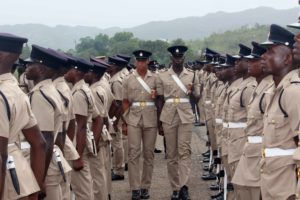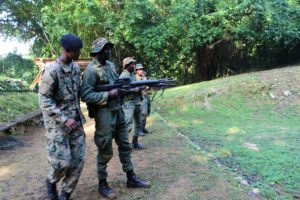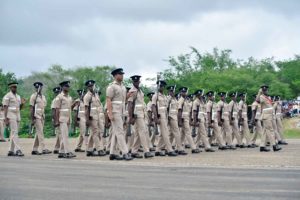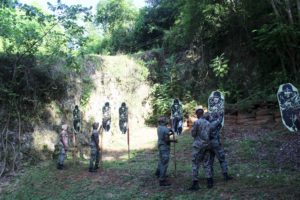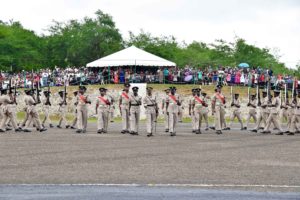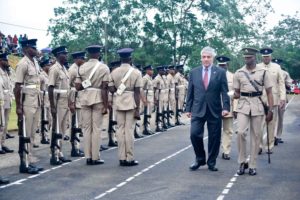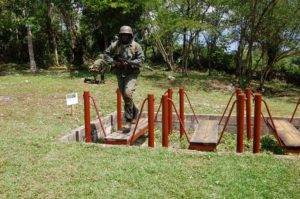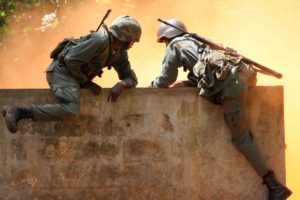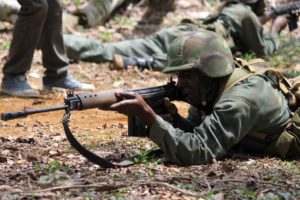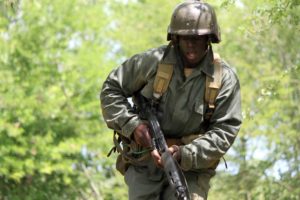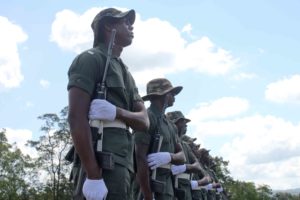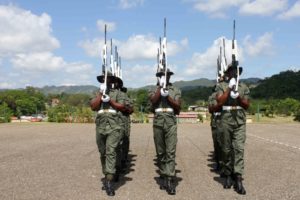Moneague Training Camp
|
The Moneague Training Camp is the home of the Second Battalion and is located 46 miles to the north west of the capital, Kingston and 12 miles to the south of Ohio Rios ( a tourist resort town). The camp has gone through many changes. As a training area and camp site its history date as far back as the eighteenth century. An island village in the parish of St Ann, there are various theories put forward to explain the name "Moneague". One version is that the name dates back to the time of the Arawaks and that "Moneague" is the modern name derived from the Arawak word "Monique" – an old Arawak settlement. Another version is that the name is a corruption of the archaic Spanish form "Monagua", meaning lonely water, and so named by the early Spanish settlers after an underground lake in the area which used to rise and fall periodically. Yet another version is that the word was derived from a combination of two Spanish words, "Monte" and "Aqua" meaning mountain water – another reference to the lake which is indeed nestled in the mountains. There is still another version which holds that the word Moneague came from the word "Moniqua" a word commonly used in Cuban dialect meaning bush and jungle. Whatever the true meaning might be , the old town has surely had Arawak and Spanish influence. It is believed that the area was populated from before the discovery of the island by Columbus. The main part of the town, as it stands today, was laid out by the early Spanish settlers at a time when there were but a few main roads in the island. The town was in fact built on the only trans-island road which ran from Spanish Town to the north coast at the time. The Spaniards are known to have settled in the area where they engaged in cattle rearing on the large, open undulating pasture lands around. Cattle rearing is to this day continued as one of the economic ventures of the area engaged in by large and small farmers alike. Following the invasion of Jamaica by the English in 1655 and the subsequent fall of Spanish Town, Christoval Arnaldo de Yassi, the last Spanish Governor of the island, was said to have made a stand in the Moneague area where he set up his new and temporary Headquarters. Here he set about organizing the freed slaves into fighting bands with instruction to take to the hills and from there to attack and harass the British. These freed slaves later became the famous Maroons. However, despite his valiant rear-guard actions, Ysassi was beaten in subsequent battles fought with the English in the Moneague/St Ann area and fled to the north coast, and onwards to Cuba, in a canoe in 1660. The question of why Moneague has been a training area for so long naturally arise. The fact that it was, and still is, in a convenient location with regards to travel between Kingston, Spanish Town and the North Coast, is no doubt, one of the reasons. Another is the fact that Moneague was a strategic barrack location for British Troops during the time of the Maroon Wars. At that time also, attention had to be paid to the protection of the coast from French or Spanish invasions and many island barracks were built to house British troops for this purpose. The cool climate and open undulating terrain also lends itself to military training and must have figured in the early choice of this areas as a place to billet troops. Early history The Moneague area has been used by the Military from as far back as the middle of the eighteenth century. To deal more effectively with the Maroons during the first Maroon War (1734 to 1738), the British constructed eleven barracks across the island; six in Middlesex, two in Surrey and three in Cornwall. The barrack in Moneague was one of the six built in Middlesex. At the beginning of the conflict with the Maroons, the British Troops were quite unaccustomed to the country, the climate and the method of ambush warfare so skillfully practiced by the Maroons. The soldiers were often worn out and exhausted by the long marches that were necessary before they could make contact with these bush fighters. They were therefore at a disadvantage whenever they encountered the Maroons and suffered early losses in their clashes with them. The building of a series of barracks and fortified posts with connecting roads as close as possible to the main Maroon settlements coupled with the use of dogs and Mosquito Coast Indians, for tracking and fighting, had some positive effects on the campaign of His Majesty's troops against the Maroons and eventually led up to the Peace Treaty of 1739. After the first Maroon War, the barracks were still in use. According to CUNDALL'S Historic Jamaica' an extract from the Journal of the House of Assembly on the state of forts and barracks in the Island in May 1745 describes the one in Moneague as: " a Barrack which now lodges twenty men and capable of holding thirty… is a present water tight but will soon require new shingling… as informed by Lt TROAH." By 1774 twenty-six more barracks had been built across the island in addition to the original eleven. The old barracks were said to be in served their purpose well of strategically dispersing His Majesty's troops to deal with the threats to the island which were not so much from the French or the Spanish but rather the machinations of the many thousands of slaves who by then greatly outnumbered the whites. All the Moneague barracks built during these years have long since crumbled into ruins, but the continued use of the area by the military remains to this day. Moneague this century The camp was not always where it now stands as troops on exercise in the Moneague area used to be based at the old Moneague Hotel from as early as the 1920s. The Hotel "was used by companies of the Jamaica Battalion while they were on training in Moneague during the 1920s and 30s. The Battalion used the train extensively in Shettlewood and Montpelier areas but those areas were found to be too far away and Moneague was the preferred alternative as it offered similar terrain closer to Kingston. The Jamaica Battalion was then based on grounds of what is now the Mona Campus of the UWI, and it would usually have one company undergoing training in Moneague while the remainder of the battalion was on duty in Kingston. Many British and Canadian Regiments conducted field training in Moneague at the time as well. The Canadians did in fact use Moneague Camp extensively throughout the years of the Second World War. The Winnipeg Grenadiers trained in Jamaica for about a year at the start of World War II. Before then, the British had a regiment (The Kings Shropshire Light Infantry) here for eighteen months. Of all the Canadian Regiments to have stayed here, the Argyle and Sutherland Highlanders were billeted there for over two years during the War. In 1944 'The Brocks' (another Canadian Unit) came to Jamaica relieving in the process the Irish Fusiliers of the United Kingdon. The Fusiliers left after the War in 1945. The reasons for maintaining a Unit in the colony of Jamaica have varied over the War years. At first when the Germans were over-running North Africa, and were intent on establishing a bridge-head in South America, the island outposts in the West Indies were vital to the defense of the North American Continent. However, by the time the 'Brocks' had arrived 'D' Day had come and gone and the reasons for billetting troops here became fourfold: to be ready for operational duty, to assist in the training of local forces, to provide the perimeter guard for the internment Camp for POWs and to provide aid to the civil power in dealing with 'negro uprisings'. While the companies stationed in Up Park Camp were occupied with camp duties, range work and platoon and company bivouacs, each rifle company was billeted in turn at Moneague for a period of four weeks. After two weeks training on battle drills in the area each company then completed field exercise under battalion supervision. They experienced, as with all others who have trained in the area, the effects in the field of tropical days and nights, the occasional irritation from poisonous plants, wood ticks and grass lice. One consolation was Jamaica had no poisonous snakes as usually found in other tropical countries. Moneague camp in its present location During the 1950s the Moneague Hotel saw less service as a barrack for troops as in 1948/49 the military gradually transferred to its present location near Walton. This movement of the camp was as a result of the hotel changing hands in 1948 when it was leased by a new proprietor, who did extensive renovations and re-started the hotel business. This venture did not last for very long as in 1956 the Moneague Hotel changed hands again, was again remodeled and became the Moneague Teachers' College. It has so remained to this day. The side near Walton was an obvious one as water for the Camp (and also the Moneague Village) was provided by a well in the vicinity which had been dug by soldiers in 1943 and was operated and maintained by the army up until recent times. Situated right next to the camp this well is still in service today supplying water to the camp and the Moneague town. The well is now the responsibility of the National Water Commission. The newly established camp near Walton was nothing more than a plot of land with little development. Tents were used to house troops and continued to be used right up to the beginning of the 1980s. The Camp is situated in an area known as Sewell's Piece which is part of a piece of land known as Moneague Hotel lands. The new lands was said to measure "24 acres, 3 roods and 13.4 poles save and except for one rood and 14.8 poles which was handed over to the Government for road improvement." This land includes the Airstrip near Walton, the Riverhead and Endeavour areas. |
|

